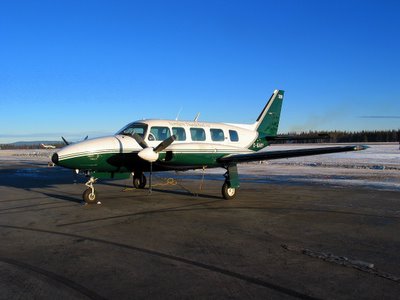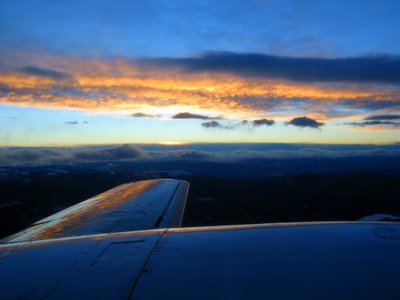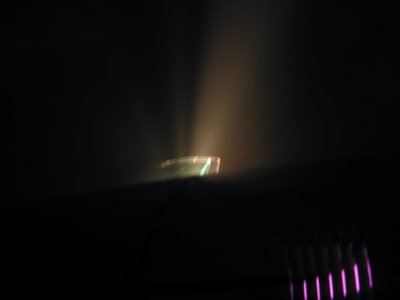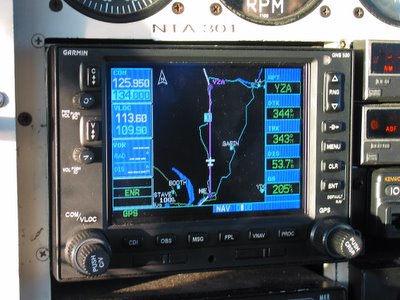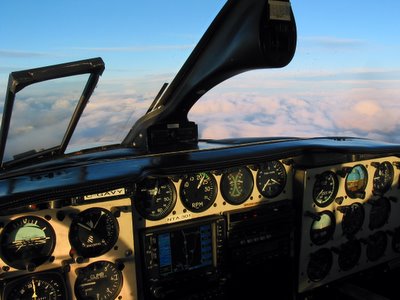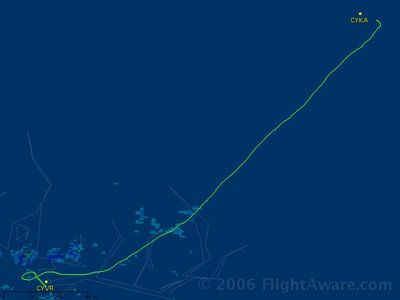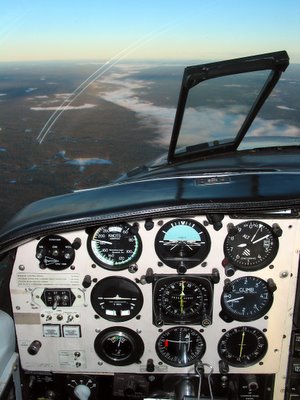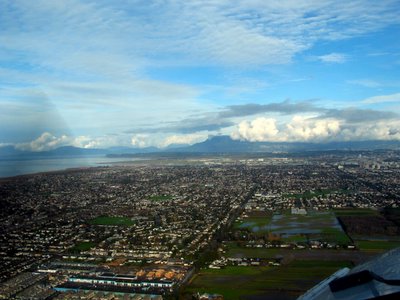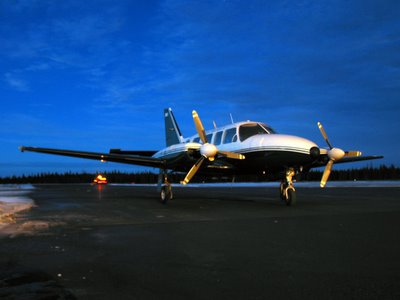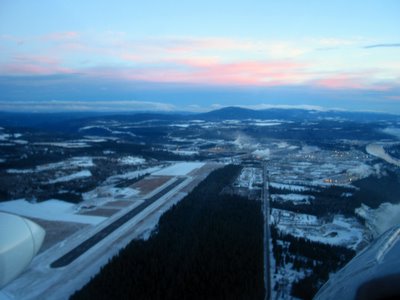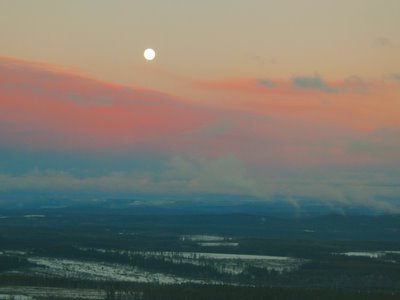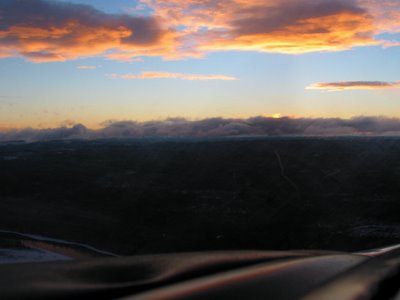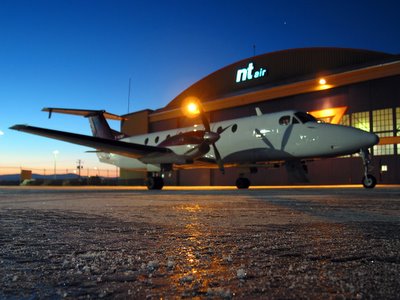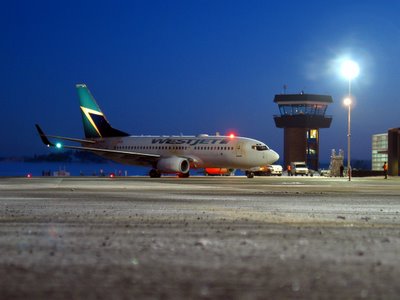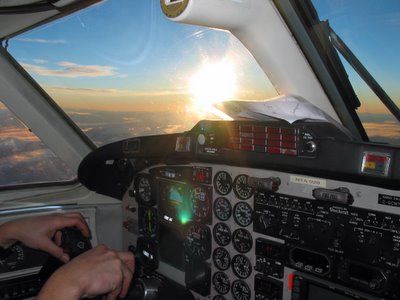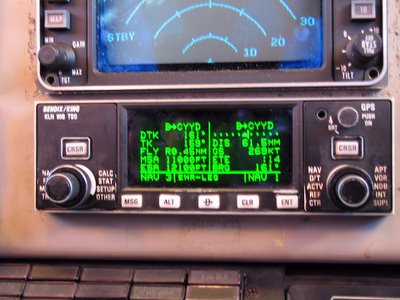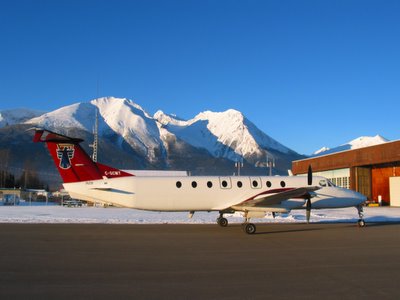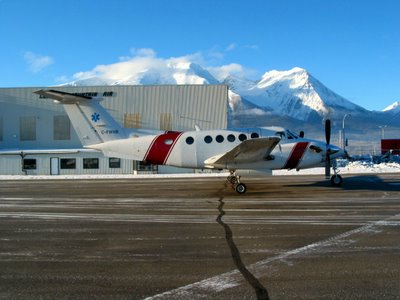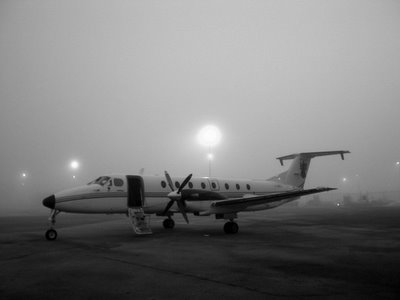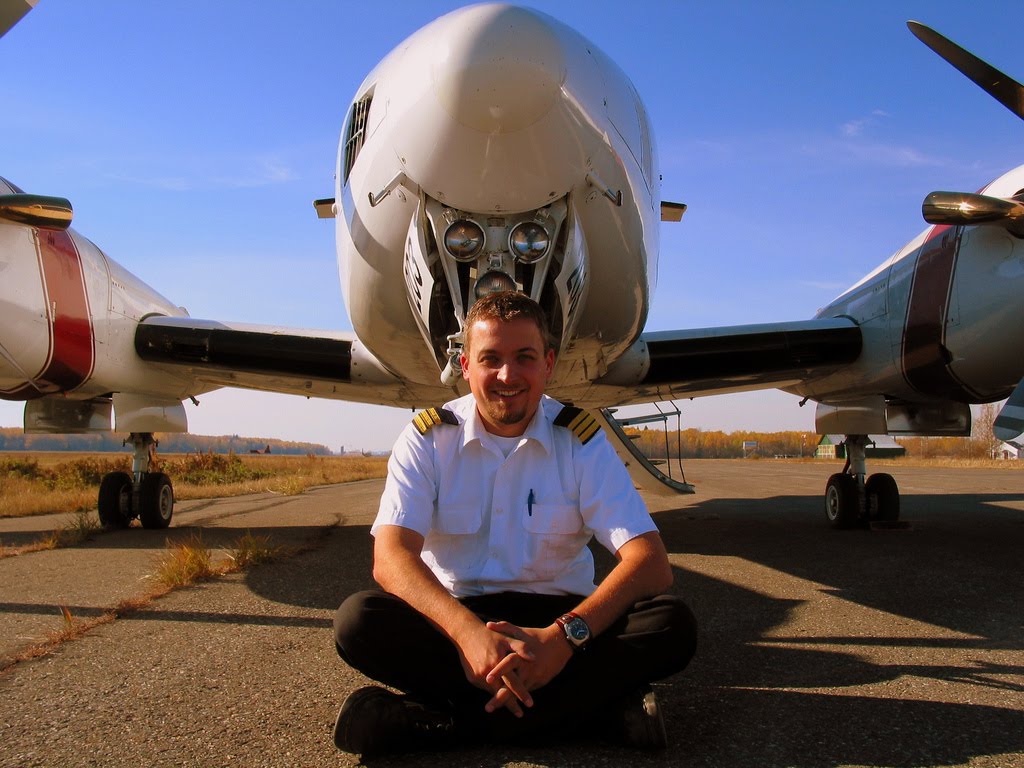Tuesday, January 31, 2006
Friday, January 27, 2006
A break from routine
 We showed up at the airport yesterday morning to find that our little airplane wasn't feeling so well and needed some TLC. So we left our 'ho' in the hands of an AME and did what we always do when we show up for work early in the morning only to find we're not going anywhere....... we went for breakfast and coffee. After a good, cheap meal at the Sushi Cafe, I made my way home thinking I was done for the day, swapped my flight suit for my pj's and set about to relaxing. The relaxing was to be short lived. It wasn't to long before the phone rang to tell me that they got the plane back in tip top shape and we would be heading out to do our run south from Williams Lake.
We showed up at the airport yesterday morning to find that our little airplane wasn't feeling so well and needed some TLC. So we left our 'ho' in the hands of an AME and did what we always do when we show up for work early in the morning only to find we're not going anywhere....... we went for breakfast and coffee. After a good, cheap meal at the Sushi Cafe, I made my way home thinking I was done for the day, swapped my flight suit for my pj's and set about to relaxing. The relaxing was to be short lived. It wasn't to long before the phone rang to tell me that they got the plane back in tip top shape and we would be heading out to do our run south from Williams Lake.
After flying the same run, at the same time, every time you go flying for a few weeks, it's nice to get something a little different. We departed a gloomy Vancouver around 1530 flight planned to the Hope NDB, Bravo 22 airway to the Ashcroft NDB, followed by the Williams Lake NDB. The climb out towards Hope was mostly IMC with scattered light ice here and there. Once again, it's interesting to see the effect the Coast mountains have on the weather in BC. The weather on the coast side of the mountains seems to always be quite different then once you're on the lee side. Once we made the turn towards Ashcroft, the clouds slowly scattered out and before long, the sky cleared up to reveal the sunshine. The rest of the flight was gorgeous and we got to see some sights we don't regularly see.
Our approach into Kamloops last night was somewhat eerie. The Kamloops airport is just to the West of the City of Kamloops. The Instrument approaches all bring you in from the East, over the city. At night, there is nothing to give reference to the terrain around Kamloops except the city itself. So even if it's a crystal clear night, we end flying past the Airport, over the city and descending over the lights to assure we're clear of the terrain. This all works out great except for the fact that the dominant winds in Kamloops are out of the east and favour runway 08. So we end up with two options now, land with a tail wind, or do a night circuit for runway 26. I don't mind taking a tail wind up to around 10 knots. The runway is 6000' long and I only need a third of that to land the Navajo. However, last night the winds were blowing steady over 10 knots and gusting upwards of 20. So landing with a tailwind was not an option, leaving us to join the left hand circuit for runway 26. Because of the terrain near the airport, the night circuit is almost like an instrument approach. There is a set procedure laid out in the Canadian Flight Supplement as well as in the CAP.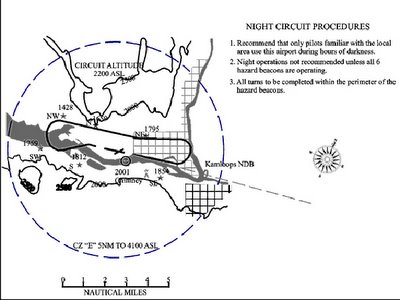
It requires 6 red flashing hazard beacons up on the hillsides be fully operational and that we fly within these beacons at an altitude of 2200' ASL. The first time one does this procedure they'll quickly understand why it exists. Although you're a safe distance from the hillside, it really seems right beside you and rising rapidly, however, aside from these flashing red lights, you see nothing ahead and to the right as you come up beside the airport on the downwind leg. So it's kind of creepy looking into the blackness beside you knowing full well there's terrain there, but not being able to see it. I find myself triple checking the procedure to make sure we're doing it right. The night circuit procedure has been conducting lord knows how many times over the years without any hiccups, so it's completly safe, but it still feels wierd. I actually think a Localizer backcourse approach, or a GPS approach from the West onto runway 08 would serve Kamloops well. I would certainly prefer that over the status quo.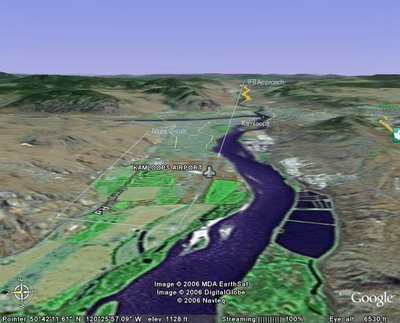
Coming into Vancouver was slightly different also. The winds at YVR last night were steady above 10 knots favouring runway 12. Aside from the odd aircraft departing 08R, almost all the traffic was using 12, something that doesn't happen all that often. We did our regular Booth arrival and got vectors from the Pitt Meadows VOR radial 260 (the Pitt 260) over the approach for 12, then back around on a kind of right base, squeezing in behind KD Air's Navajo and infront of a Westjet 737. By 2100 the plane was parked, the paperwork was done and we joined a gathering at the Beaver where the boss bought us a couple cold ones and steak dinner..... Not a bad day...
Posted by
Lost Av8r
at
8:47 AM
2
comments
![]()
Sunday, January 22, 2006
Too Many Posts like this...
3 dead, 5 hurt in Vancouver Island plane crash
Last Updated Sun, 22 Jan 2006 10:51:18 EST
CBC News
A coroner's inquest will look into a plane crash on Vancouver Island that killed three and injured five on Saturday.
The Sonicblue Airways plane was carrying six adults, one child and a baby when it crashed outside Port Alberni on the west coast of Vancouver Island.
The RCMP has confirmed that the male pilot a three-year-old child were killed in the crash, but did not have information on the third fatality.
The flight from Tofino to Vancouver went down as it approached the airport in Port Alberni.
The pilot of the nine-seater Cessna radioed for an emergency landing, but the airport lost contact with the plane just before the crash.
Capt. Cheryl Robinson of Canadian Forces expected three of the five injured who were flown to a Comox hospital would be flown to Victoria on Sunday.
They are listed in critical condition.
The names of those involved will be released after the next of kin are told.
A Canadian Forces plane flying in the area saw the Cessna, and two rescuers parachuted from a search-and-rescue helicopter to the crash site. Two others landed with the helicopter.
The Transportation Safety Board of Canada is investigating.
Sonicblue, based in Richmond, B.C., flies charter and scheduled routes.
Sounds like the pilot fought till the last moment and people are going to live because of it. I'm saddened by this loss and my thoughts are with the friends and families of those who didn't make it through, and the folks at SonicBlue..:(
Posted by
Lost Av8r
at
4:06 PM
8
comments
![]()
Thursday, January 19, 2006
Sunny Days
Turned out the arrival into Vancouver monday night was a non-event. Yesterday was a gorgeous day in the interior, reminded me of summer.
Posted by
Lost Av8r
at
11:42 AM
3
comments
![]()
Monday, January 16, 2006
"Navajo and Caravan ahead on your route are returning to Vancouver due to severe icing"
This is what we heard 1000' off of 08 right this morning coming out of Vancouver. Regency had two airplanes, a Navajo and a Caravan, also heading to Kamloops, that were flying the same route that we normally take. ATCs preferred routing from Vancouver to Kamloops takes us off the airport to intercept V300 towards Hope and then to Kamloops. Had we taken off 15 minutes or so earlier this is the route we would've taken. The V300 goes over the North shore mountains in the vicinity of Abbotsford and Chilliwack. With the very moist storm moving into BC today, the icing is no surprise. However, usually by the time we're that far inland, the severity of it is weakened. Today, that doesn't seem to be the case, and after hearing that two planes were forced back from that route, I wasn't all that keen on venturing out that way myself.
So, back to our departure. When asked what we wanted to do, my co-pilot suggested we get vectors south and climb out in the open Fraser valley.
"Yep, that'll work fine for me, lets give that a shot"
We got our turn South, towards the V342 and an intersection called YARRO, and proceeded to climb up to 13,000'. Through 11,000' we broke out on top of a layer to clear skies.
"Center, NTA301, we're leveling one three thousand, on top, with a trace to light icing in the climb, we can take a turn enroute now"
"NTA301, Cleared direct the Kamloops NDB"
"Direct the Kamloops beacon, thanks, NTA301"
Although a little behind schedule, it was daylight and VFR conditions in Kamloops, no approach required when we arrived. The trip up to Williams Lake was also pretty much done in VMC. Now we're relaxing in Williams Lake for the day, breakfast already done. A quick Pilot report check upon arrival here showed this..
UUA /OV YVR 053045/TM 1510/FL095 / TP PA31/ IC MDT-SEV MXD ICG/ RM PA31 AND C208
Doesn't sound like fun. As time goes on the Storm is supposed to push further inland, giving snow showers to the Interior of BC. The Graphic Area Forecasts, forecasting the normal moderate icing around the coast before we left this morning, now show a dark blue patch of severe icing along the North shore mountains, right to the end of the forecast period. I wonder how the Booth arrival is going to go tonight....
Posted by
Lost Av8r
at
11:36 AM
3
comments
![]()
Saturday, January 14, 2006
Served On Ice
 This time of year ice is pretty much a way of life flying around BC. It's something we're searching for when we're looking over the weather. Luckily, the airport in Vancouver is usually pretty ice free. Climbing out over the North Shore mountains can be a different story. As the moist air comes off the Georgia Strait, it's forced up by the Mountains, cooling until it freezes, and climbing upwards, sometimes over 20,000'. The Icing can get to the point were certain aircraft will fly out over the Fraser Valley, before turning Northbound, in order to climb on top of the icing over the North Shore. Once on the ground, getting the aircraft ice free and keeping it ice free for the next departure could be a challenge.
This time of year ice is pretty much a way of life flying around BC. It's something we're searching for when we're looking over the weather. Luckily, the airport in Vancouver is usually pretty ice free. Climbing out over the North Shore mountains can be a different story. As the moist air comes off the Georgia Strait, it's forced up by the Mountains, cooling until it freezes, and climbing upwards, sometimes over 20,000'. The Icing can get to the point were certain aircraft will fly out over the Fraser Valley, before turning Northbound, in order to climb on top of the icing over the North Shore. Once on the ground, getting the aircraft ice free and keeping it ice free for the next departure could be a challenge.
Most of the time we can use simple methods to keep the aircraft clean. Wing covers and brooms are usually the first lines of defense. Next in line, and the method I've used the most would be small sprayer (think a 2 gallon garden sprayer) full of glycol (we call it a piss can). Nine times out of ten, the above works great and is pretty cheap, at least compared to the final alternative. Finally, if we can't clean the airplane with the above methods, we attack it with hot glycol. This is what folks would normally see when they're at the airport. The big truck with the lift soaking down airplanes with a pressurized spray like a mini fire hose. Only twice have I ever crewed an airplane that required calling out the truck.
In the above photo, we had just finished shooting the ILS/DME rwy 33 into Terrace. The ice we picked on the descent and approach was pretty minimal. In Terrace, it was raining steadily and the temperature was a few degrees above zero. Normally, this would be a good thing, as the ice picked up on approach would just melt and fall off. However, after cruising up at 23,000', the -30 degree air cooled down the fuel in the wings to well below freezing. The cold fuel kept the surface of the wing around the fuel cells below freezing. The rain that fell onto the wing turned quickly into a rough layer of ice. We tried the piss can, but it was beyond the abilities of a little glycol at room temperature. So, we had to call out the deice truck. A quick 2 minute spray of the wings cleaned the whole thing up and we were on our way....
Posted by
Lost Av8r
at
12:33 PM
0
comments
![]()
Wednesday, January 11, 2006
On The Move
 I got a call from our Chief Pilot this past Friday. With all the extra work we've been doing, the company has decided they're moving their Navajo down to Vancouver to do a run from Vancouver, up to Kamloops and Williams Lake, and they would like me to see it safely through the sky. So I'm in Williams Lake all week to do my training on the PA31 Navajo chieftain. Though not a turbine and not as new as the 1900, it's a very nice airplane, well kept, and has a few cool features including a Garmin GNS 530 GPS. Hopefully we'll get this done by weeks end at which time, I'll have four current PPCs....not bad. :)
I got a call from our Chief Pilot this past Friday. With all the extra work we've been doing, the company has decided they're moving their Navajo down to Vancouver to do a run from Vancouver, up to Kamloops and Williams Lake, and they would like me to see it safely through the sky. So I'm in Williams Lake all week to do my training on the PA31 Navajo chieftain. Though not a turbine and not as new as the 1900, it's a very nice airplane, well kept, and has a few cool features including a Garmin GNS 530 GPS. Hopefully we'll get this done by weeks end at which time, I'll have four current PPCs....not bad. :)
Posted by
Lost Av8r
at
11:17 AM
2
comments
![]()
Wednesday, January 04, 2006
A Good Day at the Office
 It was a pretty easy day of flying yesterday. I arrived at work around 0430 to depart at 0530. The great weather along the route meant that we didn't have to do much in the way of IFR approaches. We went through Williams Lake and Prince George in the dark, however, with little around either airports in the way of terrain, VFR approaches were pretty straight forward. On arrival into Kemess the freshly broken daylight revealed just a thin scattered layer of cloud. Rather then join our GPS approach, we simply descended through a hole in the cloud layer closer to the strip. From Kemess onto Smithers was sky clear, or severe VMC.
It was a pretty easy day of flying yesterday. I arrived at work around 0430 to depart at 0530. The great weather along the route meant that we didn't have to do much in the way of IFR approaches. We went through Williams Lake and Prince George in the dark, however, with little around either airports in the way of terrain, VFR approaches were pretty straight forward. On arrival into Kemess the freshly broken daylight revealed just a thin scattered layer of cloud. Rather then join our GPS approach, we simply descended through a hole in the cloud layer closer to the strip. From Kemess onto Smithers was sky clear, or severe VMC.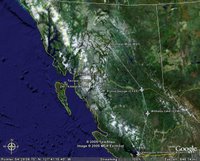 We broke out through 6500' coming into Terrace, just after we joined the ILS around Kitimat. On the Terrace to Vancouver leg, the longest leg of the day at over an hour and a half in the air, the captain and I had a pretty good discussion on economics. The time flew by (no pun intended) so quickly that I hadn't even finished up the paperwork before we started down for Vancouver (usually the paper work is done 10 minutes after we level off). The only ice we ran into was on the Keinn four arrival into Vancouver. As far as I'm concerned, if you're going to run into ice, the descent into Vancouver is the place to do it. The aircraft is going fast, so the ice comes off the boots easier. With gravity on your side in the descent, any performance lost with ice accumulating and the engine anti-ice (ice vanes, inertial seperators, whatever you want to call em) on is hardly noticable. Finally, if any ice does manage to stick around, you're going to lose it as you descend into the warm air the surrounds the airport anyways. Following some vectors from the approach guys, YVR came into site just as we caught the glideslope onto the ILS for 08L. The kind people in the Vancouver tower then gave us the sidestep onto 08R, saving us from having to taxi around the main terminal to the south side of the airport. Duty day finished at 2100.
We broke out through 6500' coming into Terrace, just after we joined the ILS around Kitimat. On the Terrace to Vancouver leg, the longest leg of the day at over an hour and a half in the air, the captain and I had a pretty good discussion on economics. The time flew by (no pun intended) so quickly that I hadn't even finished up the paperwork before we started down for Vancouver (usually the paper work is done 10 minutes after we level off). The only ice we ran into was on the Keinn four arrival into Vancouver. As far as I'm concerned, if you're going to run into ice, the descent into Vancouver is the place to do it. The aircraft is going fast, so the ice comes off the boots easier. With gravity on your side in the descent, any performance lost with ice accumulating and the engine anti-ice (ice vanes, inertial seperators, whatever you want to call em) on is hardly noticable. Finally, if any ice does manage to stick around, you're going to lose it as you descend into the warm air the surrounds the airport anyways. Following some vectors from the approach guys, YVR came into site just as we caught the glideslope onto the ILS for 08L. The kind people in the Vancouver tower then gave us the sidestep onto 08R, saving us from having to taxi around the main terminal to the south side of the airport. Duty day finished at 2100.
Posted by
Lost Av8r
at
10:49 AM
3
comments
![]()
Monday, January 02, 2006
A Trip To Smithers
This trip took us to Penticton, up Okanagan Lake to Kelowna, up to Smithers, over to Prince George, back down to Penticton, and home.
 We ocasionally steal aircraft from Central Mountain Air, our sister company. On this trip up to Smithers, we operated 'CMP' as 'Thunderbird 912'
We ocasionally steal aircraft from Central Mountain Air, our sister company. On this trip up to Smithers, we operated 'CMP' as 'Thunderbird 912'
Posted by
Lost Av8r
at
4:08 PM
0
comments
![]()
Hanging out in Fort St. John
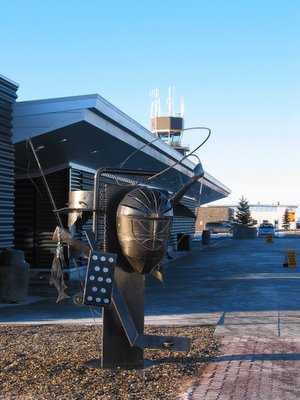 So after a pleasant Christmas break, it's back to the air. With Navair grounding themselves while investigating their accident in Terrace, there was cargo lying around that needed a new (Temporary? maybe?) way to get from A to B. We've happened to pick up some of that extra work. Twice this past week I've flown a route that takes me out of YVR around 0630, up to Prince George, Dawson Creek, and Fort St John. We arrive in Fort St John around 1100ish Mountain time, where we head to a hotel to relax until we leave to head south at 1700. This run involves splitting my duty day, something that I haven't had to do much of (if at all) during my career so far. Basically, Canadian Aviation Regulations dictate that my duty day (the time I show up to work until the time I leave) be no longer than 14 hours. However, one exception to the rule is the duty day split. If the company gives a pilot advanced warning, they can extend the duty day to a maximum of 17 hours, if they allow the pilot to rest for a minimum 4 hours in the middle of the duty day. The rest must take place in suitable accommodation (preferably your home, but usually in a hotel) and the pilot must not have the rest interrupted by the company. For this run I arrive at the airport around 0515 and don't leave until roughly 2030, requiring a duty day between 15 and 16 hours. So, we check into the hotel in Fort St John, have some lunch, and basically hang out for the rest of the afternoon.
So after a pleasant Christmas break, it's back to the air. With Navair grounding themselves while investigating their accident in Terrace, there was cargo lying around that needed a new (Temporary? maybe?) way to get from A to B. We've happened to pick up some of that extra work. Twice this past week I've flown a route that takes me out of YVR around 0630, up to Prince George, Dawson Creek, and Fort St John. We arrive in Fort St John around 1100ish Mountain time, where we head to a hotel to relax until we leave to head south at 1700. This run involves splitting my duty day, something that I haven't had to do much of (if at all) during my career so far. Basically, Canadian Aviation Regulations dictate that my duty day (the time I show up to work until the time I leave) be no longer than 14 hours. However, one exception to the rule is the duty day split. If the company gives a pilot advanced warning, they can extend the duty day to a maximum of 17 hours, if they allow the pilot to rest for a minimum 4 hours in the middle of the duty day. The rest must take place in suitable accommodation (preferably your home, but usually in a hotel) and the pilot must not have the rest interrupted by the company. For this run I arrive at the airport around 0515 and don't leave until roughly 2030, requiring a duty day between 15 and 16 hours. So, we check into the hotel in Fort St John, have some lunch, and basically hang out for the rest of the afternoon.
The city of Fort St John has a long interesting history. It lays claim to being the first Non-native settlement on the mainland of British Columbia. As with much of Western Canada, it owes a great deal of it's history to the fur trade. Established first as a fur trading post known as Rocky Mountain House, it would be abandoned, and re-established 6 more times under many different names, being first called Fort St John in 1821. It saw large settlement in the early 20th century when European settlers arrived to homestead the Peace district. In the late 1930's, the Fort St john airport was built as an important link on an airway from Edmonton to Whitehorse known as the Northwest staging route. Grant McConachie's United Air Transport, which was already providing regular mail service from Edmonton to the Peace River region, was itching to expand to the Yukon. After some expeditionary flights, using airstrips already in place, building their own strips, and changing from a fleet of ski and float planes to wheels, a scheduled service began.
In the late 1930's, the Fort St john airport was built as an important link on an airway from Edmonton to Whitehorse known as the Northwest staging route. Grant McConachie's United Air Transport, which was already providing regular mail service from Edmonton to the Peace River region, was itching to expand to the Yukon. After some expeditionary flights, using airstrips already in place, building their own strips, and changing from a fleet of ski and float planes to wheels, a scheduled service began. As the 30's drew to a close and war appeared on the horizon, the route from Edmonton to Whitehorse developed rapidly. Many strips were built by communities along the flight path,with the hopes that McConachie's airline would land on their strip. As well, upgraded radio beacons were installed allowing for safer flight. In 1939, United Air Transport became Yukon Southern Air Transport. Passengers and mail flew into Fort St John from Vancouver and Edmonton where they transferred onto one aircraft for the flight up to Whitehorse. McConachie extended his route to Fairbanks Alaska and had plans to take his airline through Russia to the Orient. However, the attack of Pearl Harbour and the invasion of the Aleutian Islands saw YSAT's resources shifted to other areas.
As the 30's drew to a close and war appeared on the horizon, the route from Edmonton to Whitehorse developed rapidly. Many strips were built by communities along the flight path,with the hopes that McConachie's airline would land on their strip. As well, upgraded radio beacons were installed allowing for safer flight. In 1939, United Air Transport became Yukon Southern Air Transport. Passengers and mail flew into Fort St John from Vancouver and Edmonton where they transferred onto one aircraft for the flight up to Whitehorse. McConachie extended his route to Fairbanks Alaska and had plans to take his airline through Russia to the Orient. However, the attack of Pearl Harbour and the invasion of the Aleutian Islands saw YSAT's resources shifted to other areas.  The Canadian and US Government's immediately hatched a plan to build airstrips every 100 miles between Edmonton and Fairbanks. The airstrips were built for the purpose of refueling and servicing aircraft destined for Alaska and the Pacific. In order to get supplies to the strips, as well as get armed forces into Alaska quickly, a road would have to be built. Starting at Dawson Creek, and ending at Fairbanks, it took Canadian and United States Army engineers 8 months to build the 1500 mile route that is now known as the Alaska Highway. Because of their knowledge on the local area and the fact they built some of the airstrips to be used, YSAT was given permission to obtain aircraft and fuel required to support the project from the Canadian Government. This included being given 3 Lockheed 14s (the first aircraft in Canada to have flight attendants) pulled out of service from the Government's baby, Trans-Canada Air Lines. On January 31st of 1941, Yukon Southern was bought by the Canadian Pacific Railway, along with 10 other small Canadian bush operations, and became Canadian Pacific Airlines. Through the years, Canadian Pacific would become Canadian Airlines, which was recently bought by rival Air Canada. Today, Air Canada, along with it's wholly-owned subsidiary, Air Canada Jazz, still flies into Fort St John and other airfields originally serviced by McConachie's airline.
The Canadian and US Government's immediately hatched a plan to build airstrips every 100 miles between Edmonton and Fairbanks. The airstrips were built for the purpose of refueling and servicing aircraft destined for Alaska and the Pacific. In order to get supplies to the strips, as well as get armed forces into Alaska quickly, a road would have to be built. Starting at Dawson Creek, and ending at Fairbanks, it took Canadian and United States Army engineers 8 months to build the 1500 mile route that is now known as the Alaska Highway. Because of their knowledge on the local area and the fact they built some of the airstrips to be used, YSAT was given permission to obtain aircraft and fuel required to support the project from the Canadian Government. This included being given 3 Lockheed 14s (the first aircraft in Canada to have flight attendants) pulled out of service from the Government's baby, Trans-Canada Air Lines. On January 31st of 1941, Yukon Southern was bought by the Canadian Pacific Railway, along with 10 other small Canadian bush operations, and became Canadian Pacific Airlines. Through the years, Canadian Pacific would become Canadian Airlines, which was recently bought by rival Air Canada. Today, Air Canada, along with it's wholly-owned subsidiary, Air Canada Jazz, still flies into Fort St John and other airfields originally serviced by McConachie's airline.
Tomorrow I'm up early, 0330, to depart YVR at 0530. The plan is to head to Kamloops, Prince George, Kemess, and Smithers. I'll arrive in Smithers likely around 0900ish, just in time for breakfast. It'll be another split day as we'll hang out in Smithers until 1730 before leaving for Terrace (first time flying to Terrace for me) before heading back to Vancouver.
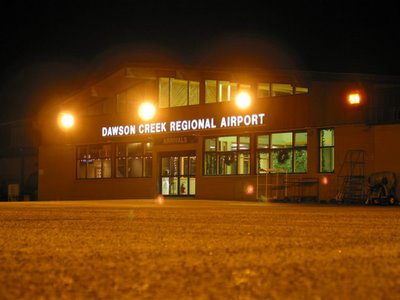 The very cozy Dawson Creek airport Terminal. Unfortunatly for us, the cafe is always closed when we go through. It looks like they serve some good meals and snacks.
The very cozy Dawson Creek airport Terminal. Unfortunatly for us, the cafe is always closed when we go through. It looks like they serve some good meals and snacks. 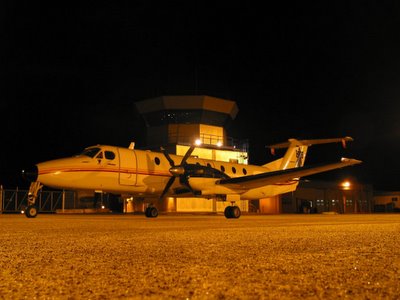 Parked in front of the Flight Service Station at the Dawson Creek Airport. Due to a declining number of flights, this FSS will soon shut down.
Parked in front of the Flight Service Station at the Dawson Creek Airport. Due to a declining number of flights, this FSS will soon shut down.
Posted by
Lost Av8r
at
1:03 PM
3
comments
![]()




